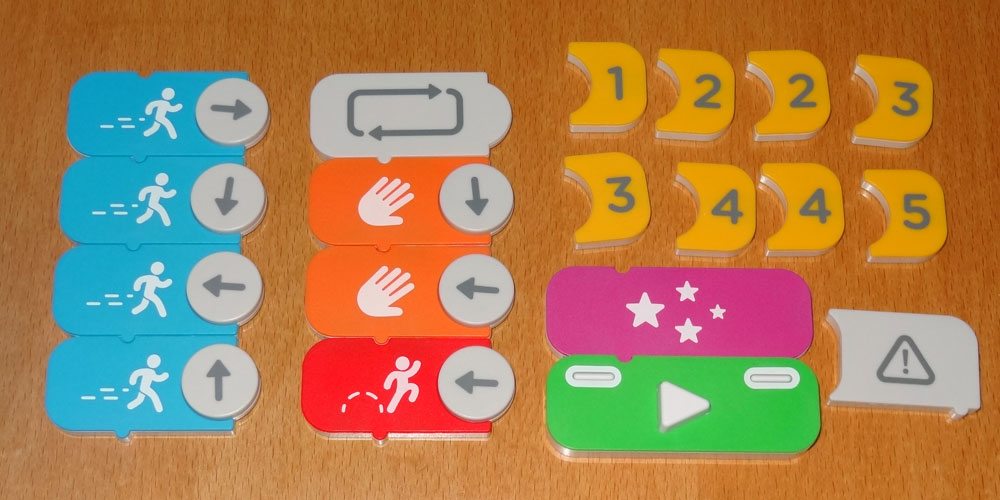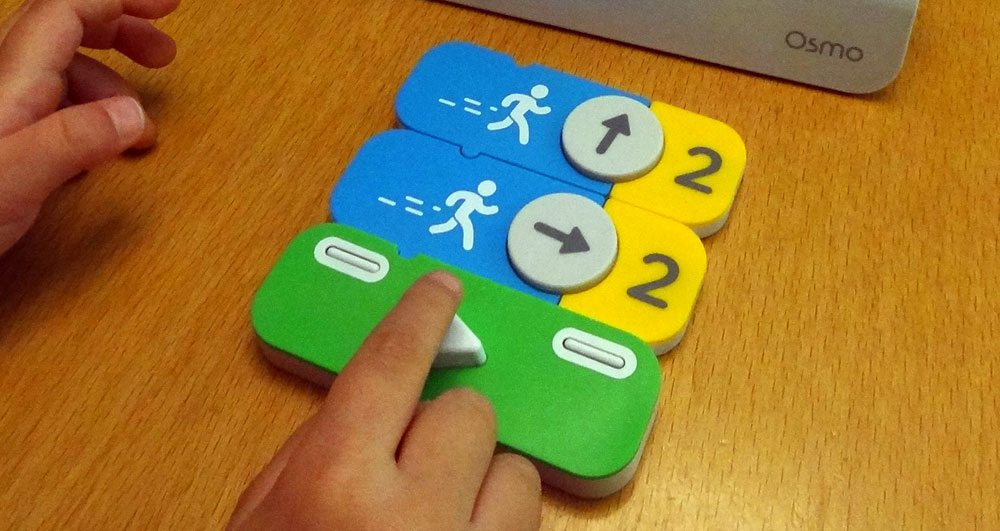
Osmo, an iPad game system that combines physical objects with digital play, has a new product: Coding. Featuring a little cartoony creature named Awbie, Osmo Coding guides kids into programming through a series of levels. I was sent a review copy of Coding to try out.
First things first: to play Osmo Coding, you’ll need an iPad with a camera—the iPad 2 up through the 9.7-inch iPad Pro will work. (The 12.9-inch iPad Pro is too wide to fit in the base.) You’ll also need the Osmo base and reflector—the base holds the iPad almost vertically, and the little reflector fits over the camera so that the iPad is “looking” down at the surface in front of it, enabling it to see and recognize the various Osmo components that are placed there. These come in the Osmo Starter Kit (which also includes the components for Words, Numbers, and Tangram), or in the Osmo Genius Kit (which adds Numbers to the other three sets). Finally, you’ll need the Osmo Coding Kit. The apps themselves are free downloads, but they’re not useful without the peripherals. I will note that none of this comes cheap; the Coding Kit on its own (if you already had the base) retails for $50.

Here’s what comes in the box:
- 8 Quantifier (number) tiles
- 4 Walk tiles
- 2 Hand tiles
- 1 Jump tile
- 1 Repeat tile
- 1 Magic tile
- 1 Caution tile
- 1 Play button
All of the bits are really nice quality, and magnetic: the action blocks attach to each other (as shown in the photo) and also if you stack them on top of each other. The number tiles attach to the sides of the action blocks easily.
The arrow portion of the action blocks can be rotated to point up, down, left, or right. I do wish there had been some ridges or something because sometimes I found them hard to turn if my fingers were dry. (My toddler’s sticky fingers had no such problem.) The Play button has a spring, so you can push down and it pops back up. When you push it down, the two white indicators at the top of the block also sink down a little, which the camera uses to detect when you’ve pushed the button.

When you fire up the app, you get a short video introducing you to Awbie, a little round critter who apparently loves strawberries. He sees a bunny hop away and runs off into the forest to chase it. Then, it’s up to you to control Awbie, programming his moves through the forest to collect strawberries and find the rabbit, who runs off toward the next level.
There are currently 16 levels, and there are plans to release two more worlds (a total of 12 more levels)—you can see in the overview map above that there are some “under construction” areas at the top right.

When you first start off, you’ll move Awbie a little bit at a time, and the app walks you through which blocks to use to move around in the level. As you progress, you’ll be shown how to string together blocks, add numbers to the actions, and even repeat actions with the Repeat tile. It starts off fairly simple, and sometimes there are little signs that give you a hint of how to approach the next section of the level. There’s a Jump tile that lets Awbie jump over low trees or water, and a Hand tile that lets him reach in a particular direction to collect a strawberry without walking there.
Later, you’ll encounter things like lily pads and floating logs—you can walk on them, but if you end movement there, you sink into the water and end up back where you left solid ground. There are little beavers who are carrying things–strawberries or wood—which you can collect, but only if you catch them. End your movement close to them without catching them, and they’ll run a few paces away. There are pies, worth more strawberries, and treasure chests with unknown contents.
As you collect strawberries, your strawberry meter adds up: fill it up, and you get a seed, which you can plant in your campground. Each plant produces strawberries, which can then be combined with logs to upgrade your camp. There’s also a little section for various animal friends that you can find as you explore the levels.

Although the levels start off pretty easy, with a pretty obvious path to get to the end, they start to become larger and more sprawling. Some levels are enormous, and you’ll see strawberries in a couple different directions and you won’t know which way to go first. The animal friends are sometimes hard to find without some more exploration. Because of things like the lily pads and logs, there are areas that are inaccessible if you’re only moving one space at a time—you have to get all the way across to dry land before you stop moving.
The other trick you’ll discover is that there’s a multiplier for the strawberries: the more you collect in a single program, the more each one is worth—even better if you multiply a pie. So although it’s not necessary to complete a level, my older kids would take the time to plan ahead so they could grab as many strawberries in one go as possible. My toddler contented herself with just moving around with very simple steps, though she could only progress so far before needing assistance. Osmo Coding is recommended for ages 5 to 12, so my toddler’s still a bit young for it, but she does enjoy the simpler levels and watching the rest of us play. I was worried at first that it wouldn’t hold the interest of my older kids as much, but they’ve both been excited to play it, too—and I’ve enjoyed it myself.
So the question I’ve been asked is: Is Osmo Coding better than, say, playing Robot Turtles or spending some time on Code.org? Well, the cute animation and campground-building aspects are definitely things that will grab your kids’ attention, and for the most part it will require less parental involvement than Robot Turtles—though it’s up to you whether that’s a positive or negative. Code.org is a great way to start learning many of the same lessons you’ll learn in Osmo Coding—and, in fact, you can pick courses that are tailored to your reading level and programming skills, for free! But there is still something kind of magical in the way Osmo combines the physical and digital world that isn’t quite the same as dragging blocks of code around on the screen. If you already have the Osmo base system, I think Coding is a great addition that expands the repertoire in a good direction.
For more information, check out the Osmo website.





Was wanting to know if you think this is suitable for a 9 year old.
Hi, Alice—my middle daughter just turned 10 recently, and she enjoys it. The earlier levels are pretty simple and won’t be as much of a challenge, but then it does ramp up. At the beginning, it’s more linear—there’s one particular path that takes you from the start to the end. But then as you progress through levels, the maps get bigger, so you have to use the programming to explore, and find where the ending is. There’s also a multiplier effect that happens for collecting a lot of strawberries in one sequence (instead of executing one action at a time), and my older kids enjoyed trying to maximize that. My three-year-old is still learning the basics, so she’s generally doing just one action at a time.